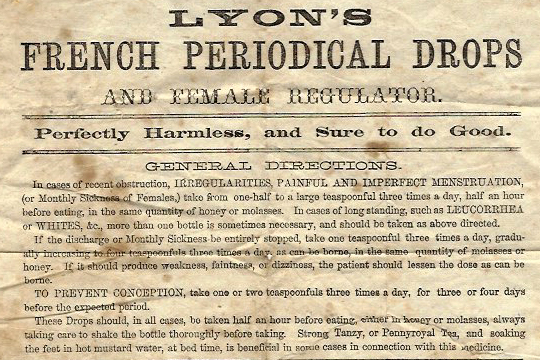The Roe v. Wade decision derived a right to abortion from the 14th Amendment’s right to privacy. The Dobbs decision decided against this previous ruling, the Supreme Court ruling that the federal government cannot guarantee access to abortion under this protection. It is now a “permittance:” up to the states to either limit or guarantee, or Congress to federally guarantee or limit with the passage of new laws. I seek to explore how abortion is remembered as a right within American society, and how that did or did not affect the lack of federal legislation guaranteeing it. This has implications for other Supreme Court-derived rights as well, such as gay marriage, and the re-implication of abortion laws in states that never repealed them following Roe v. Wade.

Rights and Permittances: The Public Perception of Abortion in Shaping Legislation
At the United States’ inception, abortion was not seen as a right, but was regularly practiced. Inheriting from the British legal tradition, abortion was not considered a crime so long as it was performed prior to quickening – that is, prior to the mother being able to feel movement in the womb, typically occurring at 16 to 20 weeks into a pregnancy. By the mid-19th century, abortion was legal in 21 out of 33 states; in places where it was a crime, women were rarely prosecuted for it. This might strike modern Americans as surprising; indeed, pro-life policies are often associated with tradition, with the Christian religion that arrived on American soil with the very first colonists, an ancient thing for such a young country as the United States.
Scientific Progress and the Perception of Life
Scientific progress lead to the revelation that quickening is a fairly arbitrary method of determining life; it became known that a fetus gradually grows from a fertilized egg into an infant. Physicians led a movement to ban abortion on the grounds of a scientific definition of human life, and a desire to uphold the Hippocratic Oath. They had mixed success. On the one hand, efforts peaking in the in the Reconstruction Era, led by such figures as the controversial Horatio Storer and Anthony Comstock of Comstock Law fame, resulted in abortion being a felony in every state by the year 1900. Confounding this, however, were new public attitudes surrounding the topic developing. New ways of thinking about women’s health resulted in an increased demand for access to both contraceptives and abortion. Margaret Sanger’s American Birth Control League was founded in 1921, under the belief that the health of women, the families they raise, and thus society at large was greatly benefitted by women being able to control when and how many children to bear. This viewpoint, which combined views of both eugenics and feminism popular during this era, was not shared by all. The feminist line of thought in particular has not always been so uniform as might be imagined in the mind of the public. Indeed, of the Reconstruction Era feminists, many, such as Susan B. Anthony and Elizabeth Stanton, were opposed to abortion in the sense that it was a “undesirable necessity forced upon women by thoughtless men” (Mohr). Later feminists, namely those of the second-wave generation beginning in the 1960s, took a firm stance on abortion being an important aspect of female liberation, a position that has taken hold in the popular American memory as one strongly linked to feminism as a whole.
Bans advance in the early 20th century, by the 1960s abortion is illegal in most states. During this time…
- Were abortions still practiced?
- Were laws enforced?
- Did women feel entitled to an abortion or not?
- Which groups were pro-abortion? Which groups were anti-abortion? (make exceptional note of women’s political organization i.e. early vs later feminists, Sanger and early 20th century eugenicists, etc)
Roe v. Wade: A Right Codified in Law and Memory
Roe v. Wade derives an explicit right to an abortion from the Fifteenth Amendment. Since then, abortion is more and more thought of as a “right” in the minds of many Americans. A few remember the circumstances of the case and note that it is on legally shaky ground. Perhaps a good point to bring up the national approval rating on abortion legality in 1973 to present day (<50% to >50%). Link the memory of abortion as a right to the lack of legislative effort on actually federally creating that right during those 50 years.
Was it never a right, always a right, or something in-between?
The Dobbs ruling asks: “How does a right to privacy mean you can’t ban abortion? We ban all sorts of things done in private.” Now abortion is a legal permittance, up to the states to allow or guarantee, or federal legislation doing the same. The memory of abortions role in society is currently divided among different factions, philosophies, faiths, and personal beliefs. The Dobbs decision, a mere ruling on the nature of the US Constitution, has become a flashpoint for mutually exclusive thoughts on what constitutes a human, if not a legal right. i.e. note that many pro-life groups celebrate the victory as divine justice and not a correction of a previous legal mistake, and how pro-choicers adopt rhetoric of a fundamental human right being infringed, a right that if not deriving from the Constitution, is innate.
Adrian Dujmusic
Preliminary sources:
https://www.law.cornell.edu/constitution-conan/amendment-5/right-to-an-abortion
https://archive.org/details/abortioninameric00mohr/page/n15/mode/2up (Mohr, James C. (1978). Abortion in America: The Origins and Evolution of National Policy. Oxford University Press.)
https://www.congress.gov/bill/117th-congress/house-bill/3755 (potential federal legislation)
https://www.congress.gov/bill/117th-congress/senate-bill/4132 (potential federal legislation)
https://www.lgraham.senate.gov/public/_cache/files/3065785d-86b8-4d36-986a-72aa1c8f100c/protecting-pain-capable-unborn-children-from-late-term-abortions-act-.pdf (potential federal legislation)
https://library.blog.wku.edu/tag/abortifacients/ (image source)